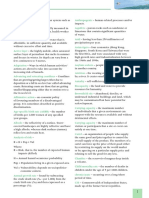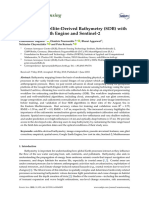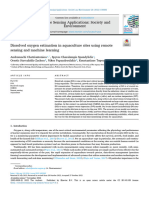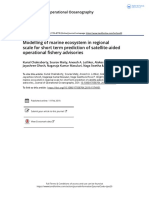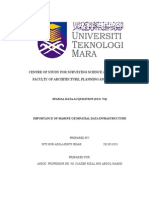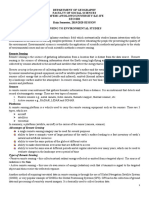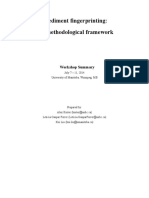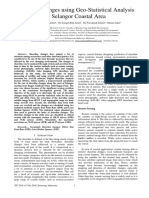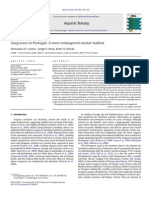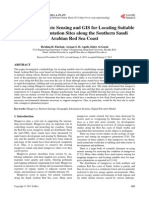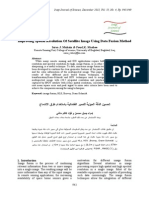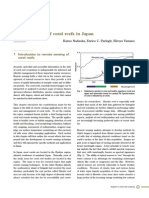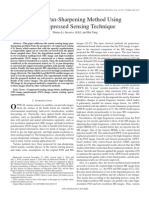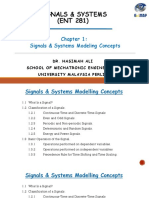Application of Knowledge-Based Expert System Model For Fishing Ground Prediction in The Tropical Area
Application of Knowledge-Based Expert System Model For Fishing Ground Prediction in The Tropical Area
Uploaded by
RiskahMappileCopyright:
Available Formats
Application of Knowledge-Based Expert System Model For Fishing Ground Prediction in The Tropical Area
Application of Knowledge-Based Expert System Model For Fishing Ground Prediction in The Tropical Area
Uploaded by
RiskahMappileOriginal Description:
Original Title
Copyright
Available Formats
Share this document
Did you find this document useful?
Is this content inappropriate?
Copyright:
Available Formats
Application of Knowledge-Based Expert System Model For Fishing Ground Prediction in The Tropical Area
Application of Knowledge-Based Expert System Model For Fishing Ground Prediction in The Tropical Area
Uploaded by
RiskahMappileCopyright:
Available Formats
The Second APEC Workshop of SAKE
Application of Knowledge-Based Expert System Model for Fishing Ground
Prediction in The Tropical Area
1 Muhamad Sadly, Nani Hendiarti 1, Suhendar I Sachoemar 2, Nurjannah Nurdin3, Yoke Faisal 1, Awaluddin 1
1 Center of Technology for Natural Resources Inventory (P-TISDA),
2 Center of Technology for Agro-industry,
3 Dept. of Marine, Hasanuddin University, Makassar
Agency for the Assessment and Application of Technology (BPPT)
BPPT Bldg. II, 19th Fl., Jl. M.H.Thamrin No. 8, Jakarta 10340
ABSTRACT
A geographical information system (GIS) may be viewed as a database system in which most of the
data is spatially indexed, and upon which a set of procedures operate in order to answer queries about spatial
entities represented in the database. Geo-study deals with answering What, Where, and Why questions.
Despite the fact that GIS is a powerful tool dealing the first two questions, GIS is inferior for answering the
Why question in geo-study (Zhang and Giardino, 1992). One of the possibility way to overcome the
inferiority of GIS for answering the Why question of Geo-Studies is by integrating expert system in a GIS
to form a Knowledge-Based Expert System GIS Model. In this study, we present the result of the application
Knowledge-Based Expert System GIS Model on the prediction of the fishing ground for pelagic fish in the
coastal area of Tomini Bay (Central Sulawesi) and South Sulawesi. As input data, we used and applied a
series satellite data of sea surface temperature (SST), sea surface chlorophyll-a (SSC) and turbidity derived
from Aqua MODIS in period of 2003-2005 to understand the temporal and seasonal variability of the marine
environment of the study area, and identified the oceanographic phenomena, i.e. upwelling, front or eddy. To
generate spatial configuration of fishing ground prediction map, we developed and integrated the result of
Knowledge-Based Expert System into GIS model by using ERDAS Macro Language (EML) of ERDAS
Imagine 9.0 software. To verify this result, a series of the in-situ fishing ground spots data of the study area
were collected for the similar periods and location, and they were then analyzed by using a simple statistical
method. The result shows that fishing ground prediction derived from Knowledge-Based Expert System GIS
Model has a high accuracy level with a range of 80-90 % against the in-situ data. This result has
demonstrated that the Knowledge-Based Expert System GIS Model can be applied to predict, localize and
determine fishing ground spot areas in which their accuracy level will be determined by the completeness of
spatial knowledge of the domain expertise and the sophistication level of the programming utilities being
used.
Keywords: Remote sensing, Knowledge-based, Expert Systems, GIS, Fishing Ground
1. INTRODUCTION
It is simplest form, a geographical
information system (GIS) may be viewed as a
database system in which most of the data is
spatially indexed, and upon which a set of
procedures operate in order to answer queries
about spatial entities represented in the database.
Geo-study deals with answering What, Where,
and Why questions. Despite the fact that GIS is
a powerful tool dealing the firs two questions, GIS
is inferior for answering the Why question in
geo-study.
Expert systems, or knowledge-based systems,
are branch of artificial intelligence (AI). AI is the
capability of a device such as a computer to
perform tasks that would be considered intelligent
if they were performed by a human. An expert
system is a computer program that attempts to
replicate the reasoning processes of experts and
can make decisions and recommendations, or
perform tasks, based on user input. Knowledge
Engineers (KE) construct expert systems in
cooperation with problem domain experts so that
the experts knowledge is available at all times
and in many places, as necessary [1,2,3,4].
On the basis of previous research concerning
the design and implementation of GIS, one may
infer several requirements that a GIS should
satisfy, as well as several principles of design and
implementation that permit the satisfaction of
such requirements.
23-1
Expert System Model for Fishing Ground Prediction
In this essay, we examine both the
requirements and the associated principles, first in
general terms and then in terms of a knowledgebased GIS that has been recently implemented.
One possible way to use GIS for dealing with
reasoning based on knowledge is by incorporating
an expert system concept in a GIS.
In this study, we develop an expert system
integrating with GIS for probable fishing grounds
predictive model of economic pelagic fish in
Tomini Bay, Central-Sulawesi using remote
sensing data. The oceanographical data of Sea
Surface Temperature (SST), Sea Surface
Chlorophyll-a (SSC) and Turbidity in relation to
the oceanographical phenomena i.e. upwelling,
front and Eddy were used as input parameters of
the system to generate fishing ground prediction
map. These input data were than taking account
into the input environmental data of the
relationships established, and transforming the
knowledge bases of spatial configuration in the
form of IF..THEN type of production rules into
macro programs written in ERDAS Macro
Language (EML) of ERDAS Imagine software
[5].
There appear to have been relatively few
expert systems constructed, or envisioned, for
oceanographic and maritime purposes. The
knowledge-based expert system described below
screens near real time incoming sea surface
temperature, chlorophyll and turbidity data. The
use of the expert system allows researchers to
develop the environmental model of fishing
ground prediction for further understanding of the
marine environment phenomenon as a knowledge
base that can be easily reconfigured [6].
2. BASIC THEORY OF SATELLITE
FISHERIES OCEANOGRAPHY
The optical properties in the marine surface
layer are determined by the presence of dissolved
and suspended matter. Under normal conditions,
visible light penetrates marine waters to a depth of
tens of metres. As the concentration of the water
constituents increases, i.e. the water becomes
more turbid, the penetration of sunlight is reduced
as a result of absorption and scattering processes.
Depending on the specific characteristics of the
materials present in the water, i.e. on their spectral
signature, the absorption and scattering processes
will vary with the wavelength of the incident
radiation [7]. Multispectral observations, therefore,
can be employed to estimate the nature and
23-2
concentration of the water constituents. Passive
sensors working in the visible wavelengths are
commonly used to image water colour. Active
sensors providing their own source of illumination,
can also be used but only from aircraft and for
sampling, rather than for imaging purposes.
The sea covers two thirds of the earth's
surface. To a large extent, man is dependent on it
for food species which include fish, shellfish,
marine mammals, turtles, aquatic plants and algae.
To exploit these resources more effectively,
fishermen must catch the most fish possible while,
at the same time, minimizing costs and optimizing
the scheduling of their operations. Reliable
environmental information is required from the
scientific community for these purposes. Remote
observations of the sea surface can provide a
significant part of the information needed to
assess and improve the potential yield of the
fishing grounds. The environmental parameters
most commonly measured from airborne and
spaceborne sensors are as follows: surface optical
or bio-optical properties (diffuse attenuation
coefficient, total suspended matter, yellow
substance, chlorophyll pigments and macrophytes,
commonly grouped under the general term of
ocean colour); surface temperature; vertical and
horizontal circulation features [8]. Several remote
sensing techniques can provide information
regarding surface circulation features of
importance in defining marine fish habitats. These
include the location and evolution of frontal
boundaries, upwelling areas, currents and
circulation patterns in general. Optical and
thermal characteristics of surface waters can be
used as natural tracers of dynamic patterns.
Variations in environmental conditions affect
the recruitment, distribution, abundance and
availability of fishery resources. It is not possible
to measure remotely the entire range of
information needed to assess changes in the
marine environment. Knowledge of particular
conditions and processes affecting fish
populations, however, may often be deduced
using measurements made by remote sensors, e.g.,
concentration of dissolved and suspended matter,
variations in primary production levels,
distribution of surface isotherms, location of
frontal boundaries, regions of upwelling, currents
and water circulation patterns. The parameters
providing information on these environmental
factors may allow a forecast of fish distribution or
more generally the definition of marine fish
habitats [9]. These are often easier to sense
The Second APEC Workshop of SAKE
remotely than the presence of fish. Estimation of a
fishery resource can be assisted by the
measurement of parameters which affect its
distribution and abundance. Much of the research
dealing with environmental effects related to
fisheries are concerned with the correlation of a
single parameter with the spatial and temporal
distribution of fish. It is most likely, however, that
fish respond to the sum total of environmental
factors. Thus, it becomes necessary to correlate a
large number of parameters, obtained by remote
sensing techniques, with fish distribution.
3. METHODOLOGY
3.1 Knowledge-Based Expert System-GIS
Development
A Knowledge-based Expert Systems GIS is
defined as an integrated GIS and Expert System
that is specially designed to answer the three
questions of a geo-study. A module that integrates
these two components is employed (Figure 1).
The GIS component is composed of two
main modules that facilitate answering the
What and Where questions: GIS database and
spatial analysis. The expert system component is
composed of two main modules for facilitating
answering the Why question: knowledge-base
and inference engine.
The knowledge-base of an expert system is
built based on the result of knowledge acquisition
in the form of production rules. A production rule
is composed of sets of heuristics. One of the
typical characteristics of heuristics is the use of
IFTHEN statements that represent knowledge
or guidelines through which a system may be
operated.
An inference engine is a knowledge
processing tool of the expert system component.
Its main task is to merge facts with rules to
develop or to infer or to draw conclusions about
new facts. If the rules of a knowledge base relate
to a specific domain or expertise, those of the
inference engine pertain to more general control
and search strategy for deriving inferences based
on screening, filtering, and pruning mechanism.
Figure 1: The elements of a knowledge-based
GIS
The most important element of a knowledgebased GIS is an integration module that links the
GIS spatial analysis and inference engine through
GIS database and knowledge base. In this
research, ERDAS Macro Language (EML) was
used for the expert system processing.
3.2 Study Area and Data Acquisition
The study area was located in the coastal
area of Tomini Bay, Central-Sulawesi and South
Sulawesi (Figure 2). As input data, we used the
Sea Surface Temperature (SST), Sea Surface
Chlorophyll-a (SSC) and Turbidity data derived
from MODIS satellite data of NASA. While to
verify the result of Fishing Ground Prediction
Model, we collect the in-situ data of fishing
ground spots in both areas, and the simple
statistical analysis was employed to understand
the percentage of their accuracy.
23-3
Expert System Model for Fishing Ground Prediction
Figure 3: A representational structure of the
Knowledge-Based Expert System
GIS Fishing Ground Model (KBESGIS- FG) ontology.
From the above processes, we formulated the
rules to produce the fishing ground prediction
modules as the expert system as described
bellowed :
Figure 2: Study are in the coastal area of Tomini
Bay (Central Sulawesi) and South
Sulawesi.
3.3.1 Sea Surface Temperature (SST)
o
IF SST (range : 240c - 270c) with different
1.50c, AND diamaeter > 10km, AND
located > 4 mill sea line with area 100 km2
AND deep > 100m, THEN this location is
front.
IF front have V (speed value) = 5 cm/s,
THEN this location is Fishing Ground.
IF SST (240c - 270c) with different 20c,
AND diameter > 30km, and located > 4
mill sea line with area 100 km2, deep >
100m, AND different 50c AND length >
10km,
THEN this location is Eddy Current.
3.3 Design of Knowledge-Based Expert System
GIS (KBES-GIS) Fishing Ground
In this research, we used 3 (three)
oceanographic parameters (SST, Chlorophyll-a,
and Turbidity) as input data of the KnowledgeBased Expert System GIS Fishing Ground Model
(KBES-GIS-FG) to define potential fishing
ground. These parameters were then also
processed to investigate and identify the
oceanographic phenomena (upwelling, front, and
eddy) in the study area that suspected has strong
correlation with the potential fishing ground. In
the application of the KBES-GIS-FG, we used the
daily data of SST, Chl-a, and Turbidity images as
input variables to generate the daily information
of the potential fishing ground formation. The
formulation process of the KBES-GIS-FG
ontology is presented in Figure 3.
IF area with UPWELLING criterion,
THEN predicted area as the Potensial
Fishing
Ground.
o
3.3.2 Chlorophyll
o
23-4
IF Chl-a concentration in the range of 0.3 to
2.5 mg/m3, AND that area is located more
The Second APEC Workshop of SAKE
than 4 mill sea line, AND deep more than
100m, AND acreage is 100km2 , THEN
Upwelling area.
o
Pattern
Recognition:
- FG, non FG
- Ocean Physical
Condition
IF area is called as Upwelling, THEN
Fishing Ground area.
OUTPUT
INPUT
IF Chl-a concentration < 0.3 AND more
than 2.5 mg/m3, THEN Non Fishing
Ground
3.3.3 Turbidity
o
IF turbidity value less than 10mg/lt, AND
located in more than 4 mil sea line, AND
deep more than 100m, AND have acreage
more than 100 km2, THEN Upwelling area.
IF the area is UPWELLING, THEN the
area is Fishing Ground.
IF turbidity have the chlorophyll
concentration between 0.3 to 2.5 mg/m3 ,
AND located more than 4 mill sea sea line,
AND deep more than 100m, AND have the
coverage area more than 100 km2 ,THEN
Upwelling.
IF area is Upwelling, THEN the area is
Fishing Ground.
Prediction Model
(Fishing Ground)
Observation
Analysis and
Interpretation
Modeling and
Testing/Verification
- FG, non FG proportion
- acreage of FG
- productivity
Knowledge-based Expert System
Figure.4. Prediction model of Fishing Ground.
(A proposed cyclical modeling approach)
From this model, we will understand that the
proven of the model performance will depend on
the feedback data from the in-situ field
observation and the knowledge base of the expert
system in which further investigation can be
carried out and adjusted to predict more
accurately fishing ground events and the
oceanographic phenomenon.
4. EXPERIMENTAL DESIGN
3.3.4 Predictive model for Fishing Ground (A
proposed cyclical modeling approach)
The experimental design in this research is
conducted as follows:
The modeling concept used in this research is
based on the cycling model approach (as
illustrated in Figure 4). This model consists of
three (3) stages, as described bellow :
(a). Preparation of the Knowledge-Based Expert
System GIS Fishing Ground Model (KBESGIS-FG) systems.
(a). Observation
stage:
to
define
the
characteristics of fish behavior, physical
condition of ocean and use the pattern
recognition method to cluster fishing
ground and non fishing ground.
(b). Analysis and interpretation of data (SST,
Chl-a, Turbidity images.
(c). Modeling and testing/verification: using a
knowledge-based expert system GIS model
for fishing ground prediction.
(b). Building the knowledge-base and parameter
settings.
(c). Data preparation: Satellite data (SST, Chl-a,
Turbidity), field observation data of fishing
round.
(d). Pre-processing data.
(e). Run model and validate.
5. RESULTS AND DISCUSSION
The scenes result of the KBES-GIS-FG
model in the coastal area of Tomini Bay (Central
Sulawesi) and South Sulawesi and their statistical
analysis were illustrated in Figure 5 and 6,
respectively. Three (3) input data of SST,
Chlorophyll-a, and Turbidity are used in the
model to generate predicted potential fishing
ground. The analysis processes were used the
Knowledge-Base Engineer of ERDAS software.
23-5
Expert System Model for Fishing Ground Prediction
the near border of the different water environment
(front).
A
--------------------------------------------------------------
To understand the accuracy level of the result
model, the simple statistical analysis was
employed by comparing the daily result model
and the daily field observation fishing ground data
in the similar time of the data acquisition and
observation. The result as shown in Figure 6,
indicated that the average percentage of level
accuracy of the model result in both areas of the
coastal area of Tomini Bay, Central Sulawesi and
South Sulawesi was relatively high with accuracy
level of 86 %. While the daily result of the
prediction model in the coastal area of Tomini
Bay, Central Sulawesi and South Sulawesi is
within a range of 68 % to 95 %. As mentioned
above, the variability of the accuracy level of the
model result in the prediction potential fishing
ground seems to be strong corresponded with the
cloud ness level (could cover) in which in the
tropical area to be a problem. To eliminate and
increase the accuracy level in the satellite data
acquisition, the development of technical
processes of the data satellite for the tropical area
was recommended.
Figure.5. Fishing Ground Map produced by the
KBES-GIS-FG Model in the coastal
area of Tomini Bay, Central Sulawesi
(A) and South Sulawesi (B)
The result in Figure 5 shows that the fishing
ground map which produced from the model can
be divided into two (2) categories. The first
category is potential FG area that is marked by red
color dots, and the second category is semi
potential FG area marked by green color dots.
While the black color dots is non FG area. The
KBES-GIS-FG model was applied and run by
considering the marine environmental information
identified by three (3) parameters of daily SST,
Chlorophyll-a, and Turbidity as input data. The
daily and variability result of the model in
generating predicted potential fishing ground area
was strong depend on and governed by the level
of cloud ness (cloud cover) as well as the
meteorological situation. The result also shows
that the potential fishing ground area was mostly
concentrated in the near border (front) of the high
and low concentration level of chlorophyll-a.
This result indicated and well agreement with the
most previous results that shows the potential
fishing ground is well correspond with the area in
23-6
Figure 6. The statistical analysis result of the
model and field data of fishing round.
6. CONCLUSIONS
In this paper, a knowledge-based expert
system GIS model for prediction of fishing
ground was introduced. We developed an expert
system integrated with the GIS model for
prediction of the potential fishing ground of the
economic pelagic fish in the coastal area of
Tomini Bay, Central-Sulawesi and South
Sulawesi by using Sea Surface Temperature
(SST), Sea Surface Chlorophyll a (SSC) and
The Second APEC Workshop of SAKE
Turbidity data derived from Modis satellite. The
results demonstrated that the level of the success
of implementing any knowledge based GIS model
is determined by the completeness of spatial
knowledge concerning the domain expertise and
the sophistication level of the ERDAS macro
programming. Moreover, it was found that the
use of the expert system has allowed the
development of fishing ground model to
understand further of the ocean phenomenon in
relation to the fishing ground characteristic. By
using the knowledge base expert system, the
prediction of fishing ground automatically would
be more easy and accurate.
ACKNOWLEDGEMENT
We would like to acknowledge The
Ministry of Research and Technology (KMNRT)
Republic of Indonesia through the Incentive
Research Program (Program Riset Insentif) for
funded this research. Also we would like to thank
to all members of the Center of Technology for
Natural Resources Inventory (P-TISDA), BPPT
for their support of the project.
Report P-TISDA, BPPT. 2005.
Hendiarti, N., Siegel, H., Ohde, T., 2004.
Investigation of different coastal processes in
Indonesian waters using SeaWiFS data, Deep
Sea Research Part II 51 : 85-97. (2004)
Venegas, R., P.T. Strub, E. Beier, Letelier, T.
Cowles, and A.C. Thomas, Assessing
satellite-derived variability in chlorophyll
pigments, wind stress, sea surface height, and
temperature in the northern California Current
System, J. Geophys. Res. In Press, 2007.
Laurs, R.M. et al., Albacore tuna catch
distributions relative to environmental features
observed from satellites, Deep-Sea Res.,
31(9):108599, 1984.
Kemmerer, A.J., Environmental preferences and
behavior patterns of Gulf menhaden
(Brevoortia patronus) inferred from fishing
and remotely sensed data, ICLARM
Conf.Proc., (5):34570, 1980.
REFERENCES
P. M. Atkinson and A. R. L. Tatnall, Neural
networks in remote sensing, Int. J. Remote
Sensing, Vol. 18, No. 4, 1997.
Ignizio, J.P. Introduction to Expert Systems: the
development and implementation of rulebased expert system. NewYork: McGrawHill, Inc.
Poul Degnbol, The Knowledge base for fisheries
management
in
developing
countries:
alternative approaches and methods, Institute
for Fisheries Management and Coastal
Community
Development, Bergen Norway
Published, 2004.
James C. Hendee, An Expert System for Marine
Environmental Monitoring in the Florida Keys
national Marine Sanctuary and Florida Bay,
Proceedings of the Second International
Conference on Environmental Coastal
Regions, ed. C.A. Brebbia, Computational
Mechanics
ublications/WIT
Press.
Southampton, pp. 57-66, 1998.
Sadly, Muhamad, Assessment and Applicfations
of the Knowledge-based Expert System in
Natural Resources Management, Technical
23-7
Expert System Model for Fishing Ground Prediction
23-8
You might also like
- Extracted From Potpourri AlchemiaDocument3 pagesExtracted From Potpourri Alchemialauralenci6801100% (4)
- Robbins, Peter - Wilhelm Reich. Orgone and UFOs PDFDocument168 pagesRobbins, Peter - Wilhelm Reich. Orgone and UFOs PDFLusi Florova100% (5)
- IB Geography Glossary IBDocument9 pagesIB Geography Glossary IBAnnaNo ratings yet
- Shell and Tube Heat Exchangers FormulaDocument3 pagesShell and Tube Heat Exchangers FormulayuvionfireNo ratings yet
- rs10060859 CompressedDocument18 pagesrs10060859 CompressedricNo ratings yet
- Applications of Remote Sensing in Oceanographic ResearchDocument9 pagesApplications of Remote Sensing in Oceanographic Researchhafez ahmadNo ratings yet
- Remote Sensing For Determining EvapotranDocument32 pagesRemote Sensing For Determining EvapotranSri SritharanNo ratings yet
- Application of Remote Sensing and GISDocument18 pagesApplication of Remote Sensing and GISالباب العاليNo ratings yet
- ICONETS2021 Susiatietal TSSDocument7 pagesICONETS2021 Susiatietal TSSzan zibarNo ratings yet
- Chapter 9 Application of Remote SensingDocument20 pagesChapter 9 Application of Remote SensingFarid TasimNo ratings yet
- Predicting Tidal Level in Tropical Eastern Bintan Waters Using Residual Long Short-Term MemoryDocument8 pagesPredicting Tidal Level in Tropical Eastern Bintan Waters Using Residual Long Short-Term MemoryIAES IJAINo ratings yet
- 1 s2.0 S0924796311002776 MainDocument1 page1 s2.0 S0924796311002776 MainSerkan SancakNo ratings yet
- Performance of Different Classifiers For Marine HaDocument11 pagesPerformance of Different Classifiers For Marine HaSreepriyaNo ratings yet
- 003 Confidence Levels, Sensitivity, and The Role of Bathymetry in Coral Reef Remote SensingDocument29 pages003 Confidence Levels, Sensitivity, and The Role of Bathymetry in Coral Reef Remote SensingVINESSE JUMAWIDNo ratings yet
- Chatziantoniou 2022Document10 pagesChatziantoniou 2022henrique.baccarinNo ratings yet
- Sensors: Improved Bathymetric Mapping of Coastal and Lake Environments Using Sentinel-2 and Landsat-8 ImagesDocument20 pagesSensors: Improved Bathymetric Mapping of Coastal and Lake Environments Using Sentinel-2 and Landsat-8 ImagesLennert PronkNo ratings yet
- Remote SensingDocument3 pagesRemote SensingVinu JohnNo ratings yet
- WildlifeMonitoring LaxmiDocument7 pagesWildlifeMonitoring LaxmiUlfah SariNo ratings yet
- Jgis 2015020214311283 PDFDocument16 pagesJgis 2015020214311283 PDFHerman SamuelNo ratings yet
- 2 - 11 - 2019 - Modelling - JournalOperOceanographyDocument20 pages2 - 11 - 2019 - Modelling - JournalOperOceanographynagaraja_mNo ratings yet
- Current Issues, Status and Applications of GIS To Marine FisheriesDocument33 pagesCurrent Issues, Status and Applications of GIS To Marine FisheriesKyran Joeffer EsporlasNo ratings yet
- Algoritma Guzman Dan SantaellaDocument9 pagesAlgoritma Guzman Dan SantaellaRebekah JenkinsNo ratings yet
- Assignment 2 (MSDI)Document7 pagesAssignment 2 (MSDI)Adila IshakNo ratings yet
- Assignment Gis and Rs TrueDocument29 pagesAssignment Gis and Rs TrueTheSad EmoticonNo ratings yet
- Deep Learning and Machine Learning Classification Technique For Integrated ForecastingDocument7 pagesDeep Learning and Machine Learning Classification Technique For Integrated ForecastingIAES IJAINo ratings yet
- Fish 1Document7 pagesFish 1Zachariah OverauxNo ratings yet
- ISPRS Journal of Photogrammetry and Remote SensingDocument19 pagesISPRS Journal of Photogrammetry and Remote SensingBrenda CamilaNo ratings yet
- Seo 002 - 2021Document3 pagesSeo 002 - 2021Susan OsuolaleNo ratings yet
- Comparative Analysis of Worldview-2 and Landsat 8 For Coastal Saltmarsh Mapping Accuracy AssessmentDocument13 pagesComparative Analysis of Worldview-2 and Landsat 8 For Coastal Saltmarsh Mapping Accuracy AssessmentrjhonnerieNo ratings yet
- 148Document15 pages148deniNo ratings yet
- Graphical User Interface For Benthic MappingDocument5 pagesGraphical User Interface For Benthic MappingIDESNo ratings yet
- Implementation of Low-Powered Multi-Sensor Buoy System For Coastal EnvironmentsDocument6 pagesImplementation of Low-Powered Multi-Sensor Buoy System For Coastal EnvironmentsTJPRC PublicationsNo ratings yet
- Quantifying The Discriminatory Power of Remote Sensing Technologies For Benthic Habitat MappingDocument23 pagesQuantifying The Discriminatory Power of Remote Sensing Technologies For Benthic Habitat MappingamyNo ratings yet
- Spectral Mixture Analysis and Temporal Land Sat Satellite Images For Monitoring and Change Detection: Dead Sea JordanDocument7 pagesSpectral Mixture Analysis and Temporal Land Sat Satellite Images For Monitoring and Change Detection: Dead Sea JordanInternational Journal of Application or Innovation in Engineering & ManagementNo ratings yet
- NSC 93rd PaperDocument6 pagesNSC 93rd PaperKalimuthu PaulpandianNo ratings yet
- Neumann EtalDocument8 pagesNeumann EtaleftychidisNo ratings yet
- The Estimation of Mangroves Area and Density of Mangroves Changes Use The Remote Sensing Data at Northheast Province of AcehDocument6 pagesThe Estimation of Mangroves Area and Density of Mangroves Changes Use The Remote Sensing Data at Northheast Province of AcehLia Amellya LNo ratings yet
- 1 s2.0 S0034425721003084 MainDocument26 pages1 s2.0 S0034425721003084 MainjsmnlzcNo ratings yet
- JARS WaterDocument24 pagesJARS WaterAurora MNo ratings yet
- Thesis On Surface WaterDocument9 pagesThesis On Surface WaterLindsey Sais100% (2)
- Remote Sensing ReefsDocument147 pagesRemote Sensing ReefsRoberto Hernandez-landaNo ratings yet
- Benchmarking Satellite-Derived Shoreline Mapping ADocument18 pagesBenchmarking Satellite-Derived Shoreline Mapping ATungNo ratings yet
- Sediment Fingerprinting Workshop ReportDocument11 pagesSediment Fingerprinting Workshop ReportLucasLeãoNo ratings yet
- Noaa 24340 DS1Document9 pagesNoaa 24340 DS1avabrahamNo ratings yet
- CV05 Itc2018 69 328 1 Le - NewDocument6 pagesCV05 Itc2018 69 328 1 Le - Newlegenda pratamaNo ratings yet
- Oceans 2010 IEEE RGPDocument10 pagesOceans 2010 IEEE RGPaaron mathewsNo ratings yet
- Applications of Remote Sensing Environmental Sciences Essay PDFDocument5 pagesApplications of Remote Sensing Environmental Sciences Essay PDFMuhammad AteeqNo ratings yet
- Remote SensingDocument30 pagesRemote SensingAdeel AhmedNo ratings yet
- (J) Spaceborne GNSS - R Retrieving On Global Soil Moisture ApproachedDocument6 pages(J) Spaceborne GNSS - R Retrieving On Global Soil Moisture ApproachedAhmed Wasiu100% (1)
- GIS RevirewDocument4 pagesGIS Revirewnebiyutora566No ratings yet
- Hoareau 2018Document12 pagesHoareau 2018sfreireNo ratings yet
- Madda Walabu University College of Computing Department of Information TechnologyDocument4 pagesMadda Walabu University College of Computing Department of Information Technologynebiyutora566No ratings yet
- A Proposal For Automatic Coastline Extraction From Landsat 8 OLI Images Combining Modified Optimum Index Factor (MOIF) and K-MeansDocument27 pagesA Proposal For Automatic Coastline Extraction From Landsat 8 OLI Images Combining Modified Optimum Index Factor (MOIF) and K-Meanssend2awangNo ratings yet
- Sensors 21 04649Document19 pagesSensors 21 04649ARSHIE FATHREZZANo ratings yet
- 1 s2.0 S0034425721003357 MainDocument27 pages1 s2.0 S0034425721003357 MainIoana VizireanuNo ratings yet
- NWIA Maharashtra Atlas PDFDocument240 pagesNWIA Maharashtra Atlas PDFPrithireddy ThenetiNo ratings yet
- 36 1 BresnahanDocument8 pages36 1 BresnahanDavideDicertoNo ratings yet
- 1 s2.0 S0034425717306193 MainDocument26 pages1 s2.0 S0034425717306193 MainLeoNo ratings yet
- Research EdittedDocument20 pagesResearch EdittedAbdulbasit SebsibNo ratings yet
- Experimental Verification of Maritime Target Parameter Evaluation in Forward Scatter Maritime RadarDocument9 pagesExperimental Verification of Maritime Target Parameter Evaluation in Forward Scatter Maritime RadarjuanNo ratings yet
- Principal Component Analysis For Evaluating The Seasonal Vegetation Anomalies From MODIS NDVI TimeDocument10 pagesPrincipal Component Analysis For Evaluating The Seasonal Vegetation Anomalies From MODIS NDVI TimeIJRASETPublicationsNo ratings yet
- Remote Sensing: Advancements and Applications in Computer Vision for Remote SensingFrom EverandRemote Sensing: Advancements and Applications in Computer Vision for Remote SensingNo ratings yet
- Rehab MangroveDocument16 pagesRehab MangroveRiskahMappileNo ratings yet
- Seagrasses in Portugal: A Most Endangered Marine Habitat: Aquatic BotanyDocument11 pagesSeagrasses in Portugal: A Most Endangered Marine Habitat: Aquatic BotanyRiskahMappileNo ratings yet
- Coral Remote SensingDocument15 pagesCoral Remote SensingRiskahMappileNo ratings yet
- Biodiesel Production From AlgaeDocument3 pagesBiodiesel Production From AlgaeRiskahMappileNo ratings yet
- Ijg 2013032914312232Document9 pagesIjg 2013032914312232RiskahMappileNo ratings yet
- Improving Spatial Resolution of Satellite Image Using Data Fusion MethodDocument7 pagesImproving Spatial Resolution of Satellite Image Using Data Fusion MethodRiskahMappileNo ratings yet
- Monitoring Coral Bleaching Using A Colour Reference Card: &) Æ N. J. MarshallDocument8 pagesMonitoring Coral Bleaching Using A Colour Reference Card: &) Æ N. J. MarshallRiskahMappileNo ratings yet
- 0302 Remote SensingDocument14 pages0302 Remote SensingRiskahMappileNo ratings yet
- A New Pan-Sharpening Method Using A Compressed Sensing TechniqueDocument9 pagesA New Pan-Sharpening Method Using A Compressed Sensing TechniqueRiskahMappileNo ratings yet
- Signals & Systems (ENT 281)Document60 pagesSignals & Systems (ENT 281)Yip Tuck WaiNo ratings yet
- Ladakh Ecological Development Group (Ledeg) Hostel, LehDocument27 pagesLadakh Ecological Development Group (Ledeg) Hostel, LehAstha SinghNo ratings yet
- Is - 9595Document55 pagesIs - 9595sanjeet_sengar100% (3)
- STAT1 Module Modified 1Document38 pagesSTAT1 Module Modified 1Alyssa Bianca AguilarNo ratings yet
- Geography Hon.Document18 pagesGeography Hon.Bijay Krishna DasNo ratings yet
- 5@ Intgers and Decimal Rationalno Ws (Merged)Document32 pages5@ Intgers and Decimal Rationalno Ws (Merged)svenkatk737No ratings yet
- Band Year 4Document8 pagesBand Year 4nazlina78No ratings yet
- English - Sequencing - BLP Listening Quarter 1 - Week 3Document3 pagesEnglish - Sequencing - BLP Listening Quarter 1 - Week 3Drea AnNo ratings yet
- Activity On Hazard Concept, Types, and ImpactsDocument3 pagesActivity On Hazard Concept, Types, and Impactsjulz sanchezNo ratings yet
- Objectives For Studying The TopicDocument6 pagesObjectives For Studying The Topichvntech42No ratings yet
- UGVCL SpecificationDocument28 pagesUGVCL SpecificationBijuNo ratings yet
- Man and EnvironmentDocument7 pagesMan and EnvironmentSayed Salman AttariNo ratings yet
- Tōshirō Hitsugaya Bleach Wiki FandomDocument7 pagesTōshirō Hitsugaya Bleach Wiki Fandomkrybvhf7z6No ratings yet
- Protocol On Heavy Rainfall For The Private Sector 17.02.21 Revised FinalDocument9 pagesProtocol On Heavy Rainfall For The Private Sector 17.02.21 Revised FinalLe Mauricien100% (1)
- Unit Hydrograph Jan 2014Document63 pagesUnit Hydrograph Jan 2014Ir DeneshNo ratings yet
- Listening BookletDocument2 pagesListening BookletrumindrNo ratings yet
- Chapter 5 - Nahid - July 2017Document32 pagesChapter 5 - Nahid - July 2017Abdul BariNo ratings yet
- Citizens Charter CDRRMO NewDocument12 pagesCitizens Charter CDRRMO NewRodgelyn FranciscoNo ratings yet
- Greenpeace International Annual Report 2019Document31 pagesGreenpeace International Annual Report 2019Бобёр СтрашныйNo ratings yet
- Boosting Salmon Numbers: Is Stocking The Answer or The Problem?Document34 pagesBoosting Salmon Numbers: Is Stocking The Answer or The Problem?Integrated Aquatic Resources Management Between Ireland, Northern Ireland & ScotlandNo ratings yet
- DRRR 12 1Document96 pagesDRRR 12 1josemanuelambito16No ratings yet
- Effect of Moisture On Structural Stability of PavementDocument4 pagesEffect of Moisture On Structural Stability of PavementharithaNo ratings yet
- Solved Idioms From 1971 To 2015 - Updated PDFDocument58 pagesSolved Idioms From 1971 To 2015 - Updated PDFImranRazaBozdarNo ratings yet
- Placement Test For Structure 3 - Unit 1 & 2Document10 pagesPlacement Test For Structure 3 - Unit 1 & 2Baihaqi Bin Muhammad Daud100% (1)
- Paper 4 - Energy Auditor - Set A Key: General InstructionsDocument12 pagesPaper 4 - Energy Auditor - Set A Key: General InstructionsRichard RegidorNo ratings yet
- McQuay - Air Cool SplitDocument24 pagesMcQuay - Air Cool Splitakaashmohan1No ratings yet


